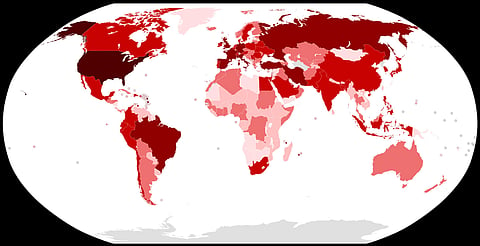

In a bid to help central and state government policymakers deal better with the COVID-19 situation, researchers from the Indian Institute of Technology Guwahati and the Duke-NUS Medical School, Singapore, have come up with a state-wise assessment of the current situation. They have also used data science models to analyse and predict the total number of infected people for different states in India over the the course of May. According to their prediction, Gujarat and Maharashtra are the two states that stand to have the major infection spurt by May 31.
The assessment was carried out by Dr Palash Ghosh, Assistant Professor, Department of Mathematics, IIT Guwahati, and PhD scholar Rik Ghosh, in collaboration with Dr Bibhas Chakraborty, Associate Professor, Duke-NUS Medical School, Singapore. Their report is based on the growth of active cases in the last few weeks, along with the daily infection-rate (DIR) values for each state.
Talking about the methodology that was used, Dr Ghosh says, "There are various data science models. One is logistic and the other is exponential. In the logistic model, the initial growth rate is slow, then it peaks up and finally stabilises. It's like an elongated S. If you look at the numbers just based on the logistic model, it will be very low. On the other hand, in the exponential model, it predicts high numbers. What we are proposing is something between both the models. We've taken the Daily Infection Rate (DIR) in each state for the last few weeks. DIR is a very good indicator. If there is a decreasing trend in the last one week, then we are going in the right direction. But, if it is not going down, it means that there are a lot more people in the community who are infected and we are not yet aware of that. We mark that state as severe. We use all these factors to combine logistic and exponential results. Then we get a much more realistic number. So right now, it looks like the numbers can go up to 1.5 lakh by the end of May."
Dr Ghosh adds, "We are not claiming that these predictions are exact, but, we hope that it will help policy makers to plan better. For instance, how many hospital beds are needed, stock of medicines, whether to extend or ease out the lockdown and other restrictions."
The professor also argues that, despite the nation-wide lockdown, people are still out of home for essential businesses, which can contribute to the spreading of the virus. The maximum value of DIR in the last two weeks can capture how severely the COVID-19 is spreading in recent times, which is why they need a combination of several data science models to get a more realistic value.
State | Observed Cumulative Cases (1 May 2020) | Maximum DIR in the last two weeks | Data-Driven Assessment of COVID-19 situation | 30-day Prediction (31 May 2020) | ||
Logistic | Linear combination of Logistic and Exponential | Exponential (Applicable only if the situation is Severe) | ||||
Andhra Pradesh | 1463 | 0.17 | Severe | 2313 | 4725 | 16502 |
Delhi | 3515 | 0.17 | Severe | 4262 | 9650 | 35957 |
Gujarat | 4395 | 0.27 | Severe | 5206 | 33736 | 110874 |
Haryana | 313 | 0.18 | Controlled | 321 | 590 | 1815 |
Jammu and Kashmir | 614 | 0.09 | Controlled | 724 | 1124 | 5170 |
Karnataka | 576 | 0.06 | Controlled | 3711 | 3711 | 3713 |
Kerala | 497 | 0.18 | Controlled | 455 | 740 | 2040 |
Madhya Pradesh | 2719 | 0.10 | Severe | 3030 | 6521 | 37935 |
Maharashtra | 10498 | 0.15 | Severe | 17115 | 43963 | 196103 |
Punjab | 357 | 0.14 | Moderate | 419 | 713 | 2517 |
Rajasthan | 2584 | 0.12 | Moderate | 2821 | 6125 | 30356 |
Tamil Nadu | 2323 | 0.12 | Moderate | 2241 | 3967 | 16624 |
Telangana | 1039 | 0.09 | Controlled | 1063 | 1631 | 7373 |
Uttar Pradesh | 2281 | 0.13 | Severe | 3016 | 6566 | 30326 |
West Bengal | 795 | 0.17 | Severe | 1261 | 3225 | 12815 |
Speaking about the data-driven state-wise assessment of the COVID-19 situation in India, Dr Palash Ghosh, Assistant Professor, Department of Mathematics, IIT Guwahati, said, “India is a vast country with a geographic area of 3,287,240 square kilometres, and a total population of about 1.3 billion. Most of the Indian states are quite large in geographic area and population. While analysing the novel coronavirus infection data, considering our entire country to be on the same page may not reveal the right picture. This is so because the first infection, new infection-rate, progression over time, and preventive measures taken by various State governments and the common public for each State are different. We need to address each State separately. It will enable the government(s) to utilise the limited available resources optimally.”
